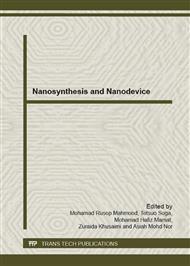[1]
M. G. Brian O'regan, Low cost and highly efficient solar cells based on the sensitization of colloidal titanium dioxide, Nature 353 (1991) 737-740.
Google Scholar
[2]
M. K. Nazeeruddin, A. Kay, I. Rodicio, R. Humphry-Baker, E. MÃller, P. Liska, N. Vlachopoulos, and M. GrÃtzel, Conversion of light to electricity by cis-X 2bis(2, 2-bipyridyl-4, 4-dicarboxylate)ruthenium(II) charge-transfer sensitizers (X = Cl -, Br -, I -, CN -, and SCN -) on nanocrystalline TiO2 electrodes, Journal of the American Chemical Society 115 (1993).
DOI: 10.1021/ja00067a063
Google Scholar
[3]
I. Chung, B. Lee, J. He, R. P. H. Chang, and M. G. Kanatzidis, All-solid-state dye-sensitized solar cells with high efficiency, Nature 485 (2012) 486-489.
DOI: 10.1038/nature11067
Google Scholar
[4]
L. Schmidt-Mende, U. Bach, R. Humphry-Baker, T. Horiuchi, H. Miura, S. Ito, S. Uchida, and M. Grätzel, Organic Dye for Highly Efficient Solid-State Dye-Sensitized Solar Cells, Advanced Materials 17 (2005) 813-815.
DOI: 10.1002/adma.200401410
Google Scholar
[5]
H. J. Snaith, A. J. Moule, C. d. Klein, K. Meerholz, R. H. Friend, and M. GrÃtzel, Efficiency Enhancements in Solid-State Hybrid Solar Cells via Reduced Charge Recombination and Increased Light Capture, Nano Letters 7 (2012) 3372-3376.
DOI: 10.1021/nl071656u
Google Scholar
[6]
M. Wang, S. -J. Moon, M. Xu, K. Chittibabu, P. Wang, N. -L. Cevey-Ha, R. Humphry-Baker, S. M. Zakeeruddin, and M. Grätzel, Efficient and Stable Solid-State Dye-Sensitized Solar Cells Based on a High-Molar-Extinction-Coefficient Sensitizer, Small 6 (2010).
DOI: 10.1002/smll.200901317
Google Scholar
[7]
M. Wang, J. Liu, N. -L. Cevey-Ha, S. -J. Moon, P. Liska, R. Humphry-Baker, J. -E. Moser, C. GrÃtzel, P. Wang, S. M. Zakeeruddin, and M. GrÃtzel, High efficiency solid-state sensitized heterojunction photovoltaic device, Nano Today 5 (2010).
DOI: 10.1016/j.nantod.2010.04.001
Google Scholar
[8]
Y. Zhenzhen, C. P. Katherine, L. Di-Jia, R. Yang, and X. Tao, Solid dye-sensitized solar cells prepared through a counter strategy for filling of solid hole transporter, Journal of Renewable and Sustainable Energy 3 (2011) 063101.
DOI: 10.1063/1.3658435
Google Scholar
[9]
G. R. R. A. K. K Tennakone, A R Kumarasinghe, K G U Wijayantha and P M Sirimanne, A dye-sensitized nano-porous solid-state photovoltaic cell, Semiconductor Science and Technology 10 (1995) 1689.
DOI: 10.1088/0268-1242/10/12/020
Google Scholar
[10]
I. K. Ding, N. Tétreault, J. Brillet, B. E. Hardin, E. H. Smith, S. J. Rosenthal, F. Sauvage, M. Grätzel, and M. D. McGehee, Pore-Filling of Spiro-OMeTAD in Solid-State Dye Sensitized Solar Cells: Quantification, Mechanism, and Consequences for Device Performance, Advanced Functional Materials 19 (2009).
DOI: 10.1002/adfm.200900541
Google Scholar
[11]
M. Cardona, Optical properties of the silver and cuprous halides, Physics Revie 129 (1963) 69-78.
Google Scholar
[12]
S.F. Lin, W.E. Spicer, and R. S. Bauer, Temperature-dependent photoemission studies of the electronic states of CuBr, Physics Review B 14 (1976) p.4551.
DOI: 10.1103/physrevb.14.4551
Google Scholar
[13]
H. Feraoun, H. Aourag, and M. Certier, Theoretical studies of substoichiometric CuI, Material Chemical Physics 82 (2003) 597-601.
DOI: 10.1016/s0254-0584(03)00318-3
Google Scholar
[14]
D. Chen, Y. Wang, Z. Lin, J. Huang, X. Chen, D. Pan, and F. Huang, Growth strategy and physical properties of the high mobility p-type CuI crystal, Crystal Growth and Design 10 (2010) 2057-(2060).
DOI: 10.1021/cg100270d
Google Scholar
[15]
V. P. S. Perera and K. Tennakone, Recombination processes in dye-sensitized solid-state solar cells with CuI as the hole collector, Solar Energy Materials and Solar Cells, 79 (2003) 249-255.
DOI: 10.1016/s0927-0248(03)00103-x
Google Scholar
[16]
J. Han, J. M. Chen, X. W. Zhou, Y. Lin, J. B. Zhang, J. G. Jia, and B. R. Sankapal, Efficiency enhancement of solid-state dye sensitized solar cell by in situ deposition of CuI, Surface and Interface Analysis, 40 (2008) 1393-1396.
DOI: 10.1002/sia.2913
Google Scholar
[17]
J. B. Mooney and S. B. Radding, Spray Pyrolysis Processing, Annual Review of Materials Science12 (1982) 81-101.
Google Scholar
[18]
G. R. A. Kumara, A. Konno, K. Shiratsuchi, J. Tsukahara, and K. Tennakone, Dye-Sensitized Solid-State Solar Cells: Use of Crystal Growth Inhibitors for Deposition of the Hole Collector, Chemistry of Materials 14 (2002) 954-955.
DOI: 10.1021/cm011595f
Google Scholar
[19]
G. R. A. Kumara, S. Kaneko, M. Okuya, and K. Tennakone, Fabrication of dye-sensitized solar cells using triethylamine hydrothiocyanate as a CuI crystal growth inhibitor, Langmuir, 18 (2002) 10493-10495.
DOI: 10.1021/la020421p
Google Scholar
[20]
M. H. M. A.R. Zainun, U.M. Noor and M. Rusop, Particles Size and Conductivity Study of P-Type Copper (I) Iodide (CuI) Thin Film for Solid State Dye-Sensitized Solar Cells, IOP Conference Series: Materials Science and Engineering 17 (2011) 012009.
DOI: 10.1088/1757-899x/17/1/012009
Google Scholar
[21]
K. Fredin, E. M. J. Johansson, T. Blom, M. Hedlund, S. Plogmaker, H. Siegbahn, K. Leifer, and H. Rensmo, Using a molten organic conducting material to infiltrate a nanoporous semiconductor film and its use in solid-state dye-sensitized solar cells, Synthetic Metals, 159 (2009).
DOI: 10.1016/j.synthmet.2008.06.029
Google Scholar
[22]
R. R. Khalid Siraj, Electrical Conductivity Behavior of CdHgI4 – CuI Mixed System, International Journal of Chemistry3 (2011) 174-179.
Google Scholar
[23]
M. Bouderbala, S. Hamzaoui, B. Amrani, A. H. Reshak, M. Adnane, T. Sahraoui, and M. Zerdali, Thickness dependence of structural, electrical and optical behaviour of undoped ZnO thin films, Physica B: Condensed Matter 403 (2008) 3326-3330.
DOI: 10.1016/j.physb.2008.04.045
Google Scholar
[24]
S. Mridha and D. Basak, Effect of thickness on the structural, electrical and optical properties of ZnO films, Materials Research Bulletin 42 (2007) 875-882.
DOI: 10.1016/j.materresbull.2006.08.019
Google Scholar
[25]
X. -t. Zhang, I. Sutanto, T. Taguchi, K. Tokuhiro, Q. -b. Meng, T. N. Rao, A. Fujishima, H. Watanabe, T. Nakamori, and M. Uragami, Al2O3-coated nanoporous TiO2 electrode for solid-state dye-sensitized solar cell, Solar Energy Materials and Solar Cells 80 (2003).
DOI: 10.1039/b306118c
Google Scholar



